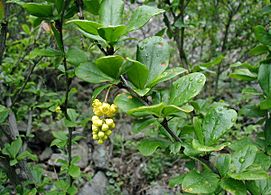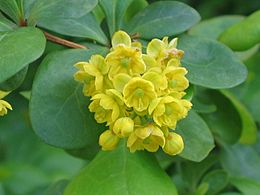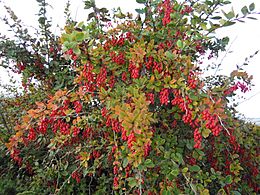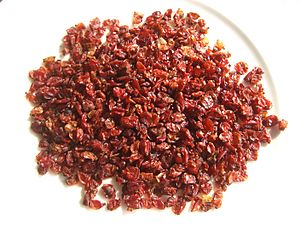Barberry facts for kids
Quick facts for kids Barberry |
|
|---|---|
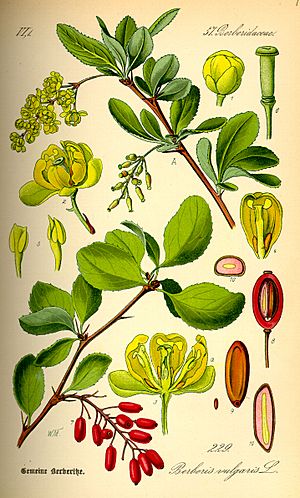 |
|
| Berberis vulgaris | |
| Scientific classification | |
| Genus: |
Berberis
|
| Species: |
vulgaris
|
The Barberry (scientific name: Berberis vulgaris) is a type of shrub that grows naturally in many parts of the world. It's also known as common barberry or European barberry. This plant is famous for its bright red berries. These berries are quite sour, but people in many countries enjoy eating them. They are often used as a tart and refreshing fruit.
Contents
What Does the Barberry Plant Look Like?
The barberry is a deciduous shrub. This means it loses its leaves every autumn. It can grow quite tall, up to 4 meters (about 13 feet) high.
- Leaves: The leaves are small and oval-shaped. They are usually 2 to 5 centimeters (about 1 to 2 inches) long. They have jagged edges, like tiny saw teeth. These leaves grow in small groups of 2 to 5, and each group has a sharp, three-branched spine underneath it. These spines are about 3 to 8 millimeters long.
- Flowers: In late spring, the barberry plant produces bright yellow flowers. Each flower is small, about 4 to 6 millimeters across. They grow in hanging clusters called panicles, which can be 3 to 6 centimeters long.
- Fruit: The fruit of the barberry is an oblong red berry. It ripens in late summer or autumn. Each berry is about 7 to 10 millimeters long and 3 to 5 millimeters wide.
Where Does Barberry Grow?
This shrub originally comes from central and southern Europe, northwest Africa, and western Asia. However, it has spread and now grows naturally in many other places. You can find it in northern Europe, including the British Isles and Scandinavia.
In North America, the barberry has also become established in the wild. It grows from Nova Scotia in Canada all the way to Nebraska in the United States. There are also populations in states like Colorado, Idaho, Washington state, Montana, and in British Columbia, Canada. People also grow it on purpose in many countries.
Barberry in Nature
The berries of the barberry plant are an important food source for many small birds. When birds eat the berries, they help spread the seeds through their droppings. This helps new barberry plants grow in different areas.
However, the Berberis vulgaris plant can also cause problems. It is a special kind of "alternate host" for a fungus called wheat stem rust (Puccinia graminis f. sp. tritici). This fungus is a serious disease for wheat and other grains. It needs the barberry plant to complete part of its life cycle. Because of this, growing Berberis vulgaris is not allowed in Canada and some parts of the United States. These areas include Connecticut, Massachusetts, Michigan, and New Hampshire.
How People Use Barberry
The berries are edible and full of vitamin C. However, they have a very sharp, sour taste. It can also be tricky to pick them because the shrubs have thorns.
- In Europe: Traditionally, people in Europe have used barberry berries to make jam. The berries contain a lot of pectin, which is a natural substance that helps jam thicken when it cools.
- In Southwest Asia: Especially in Iran, barberries are used a lot in cooking and for making jam. In Iran, dried barberries are often added to rice pilaf, giving it a tart flavor.
The Persian name for dried barberries is zerešk. Iran is the biggest producer of zerešk in the world. The South Khorasan province in Iran is the main area where zerešk and saffron are grown. About 85% of the world's zerešk comes from the Qaen region, and 15% from Birjand. People have been growing seedless barberry in South Khorasan for over 200 years. A garden where zerešk is grown is called a zerešk-estân.
Zerešk is widely used in Persian cooking. It adds a tart taste to chicken dishes. It is often cooked with rice in a dish called zerešk polo, which is often served with chicken.
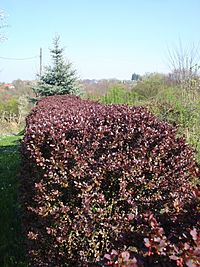
Other Ways Barberry is Used
The barberry plant has also been grown widely to create hedges in places like New Zealand.
Some Salishan groups have used "barberry" in their traditional medicine to help treat acne. However, they often used the bark of a native plant called Oregon grape (Berberis aquifolium) and other similar species.
Some Native American Indians used the roots or berries as a general herbal tonic. They believed it helped to make people feel hungry. A special liquid made from the plant was also used in folk medicine to treat stomach problems and coughs. However, its use was limited because the bark and root taste very bitter.
See also
 In Spanish: Barberis para niños
In Spanish: Barberis para niños


